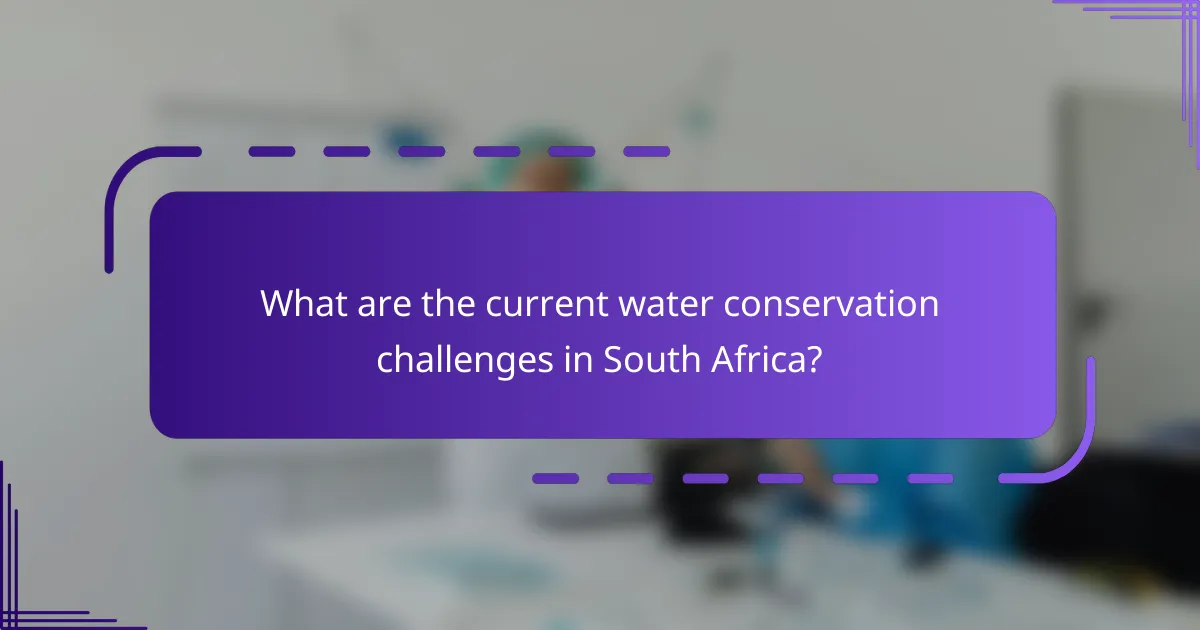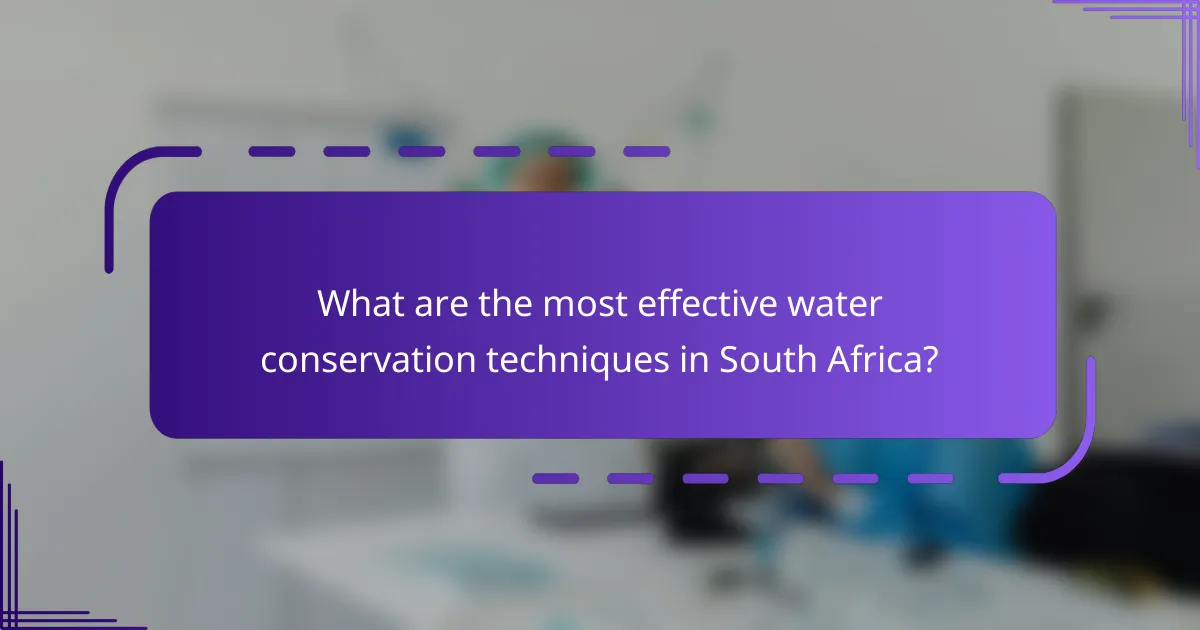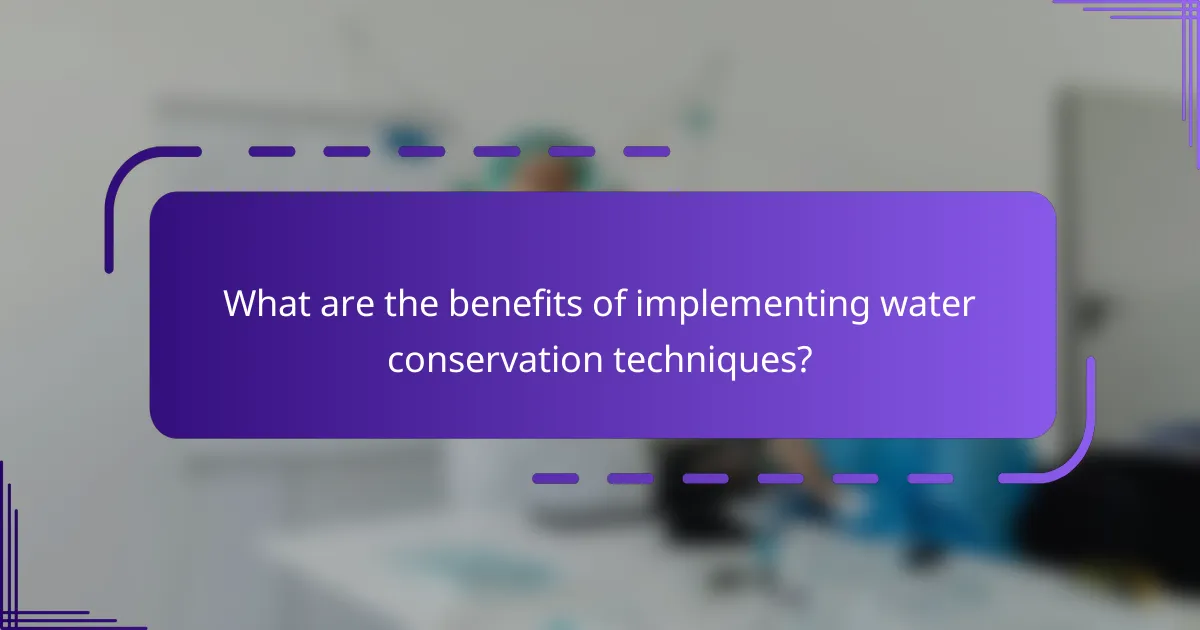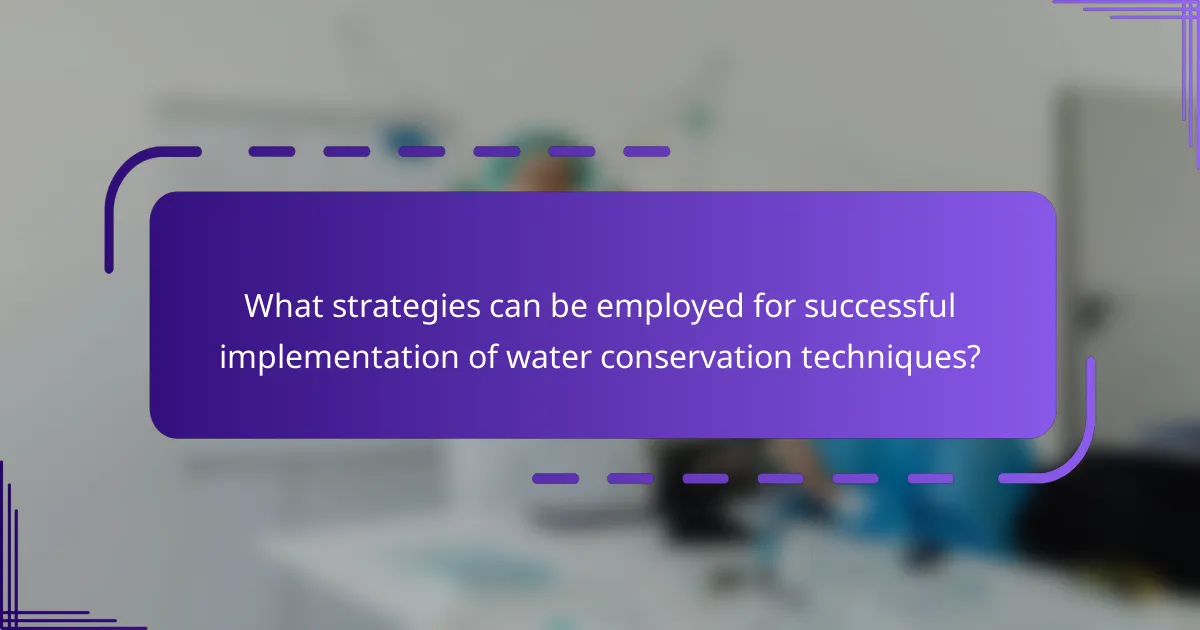Water conservation techniques in South Africa are critical in addressing the country’s severe water scarcity challenges, exacerbated by prolonged droughts, urbanization, aging infrastructure, pollution, and climate change. Key methods include rainwater harvesting, greywater recycling, and efficient irrigation systems like drip irrigation, which can significantly reduce water usage and enhance agricultural productivity. The implementation of these techniques not only conserves water but also offers environmental and economic benefits, such as lower utility costs and improved ecosystem health. Successful adoption requires education, incentives, policy frameworks, collaboration among stakeholders, and ongoing evaluation of conservation efforts.

What are the current water conservation challenges in South Africa?
South Africa faces significant water conservation challenges. The country experiences severe water scarcity due to prolonged droughts. Urbanization increases water demand, straining existing resources. Aging infrastructure leads to substantial water losses through leaks. Pollution of water sources further diminishes available clean water. Agricultural practices often waste water, exacerbating the shortage. Climate change impacts rainfall patterns, reducing water supply reliability. These challenges require urgent and effective conservation strategies.
How do climate change and population growth impact water resources?
Climate change and population growth significantly impact water resources by increasing demand and altering availability. Climate change leads to altered precipitation patterns and increased evaporation rates. These changes can cause droughts in some regions and flooding in others. Population growth intensifies the demand for water for drinking, sanitation, and agriculture. According to the United Nations, the global population is projected to reach 9.7 billion by 2050, increasing water consumption. This heightened demand can strain existing water supplies, leading to scarcity. In South Africa, where water resources are already limited, these factors exacerbate the challenges of water management and conservation.
What specific regions in South Africa are most affected by water scarcity?
The regions in South Africa most affected by water scarcity include the Western Cape, Eastern Cape, and parts of Limpopo. The Western Cape has faced severe droughts, particularly in Cape Town. Eastern Cape struggles with inadequate rainfall and infrastructure issues. Limpopo experiences high evaporation rates and limited water resources. According to the Department of Water and Sanitation, these areas are critically water-stressed. The situation is exacerbated by climate change and population growth.
How does infrastructure influence water conservation efforts?
Infrastructure significantly influences water conservation efforts by enhancing efficiency and reducing waste. Well-designed systems for water distribution minimize leaks and losses. For example, modern pipelines can cut water loss by up to 30%. Additionally, infrastructure such as rainwater harvesting systems captures and stores precipitation for later use. This practice can reduce reliance on municipal water supplies. Advanced treatment facilities also allow for the recycling of wastewater, promoting sustainable use. In South Africa, investment in infrastructure has been linked to improved water management practices. Overall, effective infrastructure is crucial for maximizing water conservation initiatives.
What are the key principles of water conservation?
The key principles of water conservation include reducing water waste, using water-efficient technologies, and promoting sustainable practices. Reducing water waste involves fixing leaks and minimizing unnecessary use. Water-efficient technologies include low-flow fixtures and irrigation systems. Promoting sustainable practices encourages behaviors like rainwater harvesting and xeriscaping. These principles help ensure the sustainable use of water resources. Implementing these strategies can lead to significant water savings. According to the South African Department of Water and Sanitation, adopting these principles can reduce water consumption by up to 30%.
What role does sustainable management play in water conservation?
Sustainable management is crucial for effective water conservation. It ensures the responsible use and protection of water resources. This approach minimizes waste and promotes the efficient allocation of water. Sustainable management practices include rainwater harvesting and the use of drought-resistant crops. These methods help maintain water quality and availability. In South Africa, sustainable management has been linked to improved water security. According to the Department of Water and Sanitation, implementing these practices can reduce water demand by up to 30%. This demonstrates the significant impact of sustainable management on water conservation efforts.
How can communities engage in water conservation practices?
Communities can engage in water conservation practices by implementing various strategies. These strategies include promoting awareness about water scarcity and the importance of conservation. Educational programs can inform residents about efficient water use. Communities can also encourage the use of rainwater harvesting systems. Installing low-flow fixtures in homes can reduce water consumption significantly. Additionally, creating community gardens can help promote sustainable landscaping practices. Local governments can support these initiatives through incentives for water-saving technologies. According to the South African Department of Water and Sanitation, community involvement is crucial for effective water management. Engaging in these practices can lead to significant reductions in water usage and promote sustainability.

What are the most effective water conservation techniques in South Africa?
The most effective water conservation techniques in South Africa include rainwater harvesting, greywater recycling, and efficient irrigation methods. Rainwater harvesting captures and stores rainwater for later use. This technique can significantly reduce dependence on municipal water supplies. Greywater recycling involves reusing water from baths, sinks, and washing machines for irrigation. This method can save substantial amounts of freshwater. Efficient irrigation methods, such as drip irrigation, minimize water waste by delivering water directly to plant roots. These techniques are essential in a country facing water scarcity. According to the Department of Water and Sanitation, implementing these methods can lead to a 30% reduction in water usage.
How do rainwater harvesting systems work?
Rainwater harvesting systems collect and store rainwater for later use. These systems typically include catchment areas, such as roofs, that direct rainwater into gutters. The water flows through pipes into storage tanks or cisterns. Filters are often used to remove debris and contaminants before storage. The stored rainwater can be used for irrigation, flushing toilets, or even drinking after proper treatment. In South Africa, these systems help reduce reliance on municipal water supplies. They can also mitigate flooding and soil erosion. Studies show that rainwater harvesting can significantly decrease water bills and promote sustainable water use.
What are the benefits of implementing rainwater harvesting in urban areas?
Implementing rainwater harvesting in urban areas offers multiple benefits. It reduces the demand on municipal water supply systems. This can lead to lower water bills for residents and businesses. Rainwater harvesting also mitigates flooding during heavy rains. Captured rainwater can be used for irrigation and non-potable applications. This practice promotes sustainable water management. Additionally, it enhances groundwater recharge. According to the South African Department of Water and Sanitation, rainwater harvesting can alleviate water scarcity. It contributes to environmental conservation by reducing stormwater runoff.
What are the maintenance requirements for rainwater harvesting systems?
Rainwater harvesting systems require regular maintenance to ensure efficiency and safety. Maintenance tasks include cleaning gutters and downspouts to prevent blockages. It is essential to inspect and clean the storage tank periodically. This helps to remove sediment and debris that can affect water quality. Additionally, checking the filtration system for clogs is crucial for maintaining water purity. Inspecting the system for leaks or damage is also necessary to prevent water loss. Routine maintenance is recommended at least twice a year, ideally before and after the rainy season. Proper maintenance extends the lifespan of the system and ensures optimal performance.
What is greywater recycling, and how can it be implemented?
Greywater recycling is the process of collecting and reusing water from household activities, excluding toilet waste. This water typically comes from sinks, showers, and washing machines. Implementing greywater recycling involves several steps. First, homeowners can install a greywater system that captures water from designated sources. Second, the collected water must be filtered and treated to remove contaminants. Third, the treated greywater can be redirected for irrigation or toilet flushing. Research shows that greywater recycling can reduce water consumption by up to 50%. In South Africa, implementing such systems can significantly contribute to water conservation efforts.
What types of greywater systems are available for households?
There are several types of greywater systems available for households. These systems primarily include gravity-fed systems, pump systems, and treatment systems. Gravity-fed systems rely on natural slope to move greywater from the source to the disposal area. Pump systems use mechanical pumps to transport greywater, especially in flat terrains. Treatment systems involve additional processing to clean greywater before reuse. Each system varies in complexity and installation requirements. The choice depends on household needs and local regulations. Proper installation and maintenance are essential for effective operation.
How does greywater recycling contribute to overall water savings?
Greywater recycling significantly contributes to overall water savings by reusing water from sinks, showers, and laundry. This practice reduces the demand for potable water. By recycling greywater, households can save up to 50% of their water usage. In South Africa, where water scarcity is prevalent, this method is especially beneficial. Implementing greywater systems can lead to substantial reductions in municipal water supply pressure. Studies indicate that greywater recycling can save millions of liters of water annually. This not only conserves water but also lowers water bills for consumers.

What are the benefits of implementing water conservation techniques?
Implementing water conservation techniques leads to significant environmental and economic benefits. These techniques reduce water waste, which is crucial in areas facing water scarcity. For instance, adopting drip irrigation can decrease water usage by up to 60% compared to traditional methods. This reduction helps preserve local water sources and ecosystems. Furthermore, conserving water lowers utility bills for households and businesses. Studies show that efficient water use can save consumers between 20% to 50% on water costs. Additionally, water conservation techniques can enhance agricultural productivity by ensuring a more reliable water supply. Effective management of water resources supports sustainable development and resilience against climate change impacts.
How do these techniques improve water quality and availability?
Water conservation techniques improve water quality and availability by reducing waste and enhancing resource management. Techniques such as rainwater harvesting capture and store rainfall, increasing the available water supply. Greywater recycling reuses water from sinks and showers, decreasing the demand on freshwater sources. Implementing drip irrigation minimizes water loss in agriculture, promoting efficient use of water resources. These methods also help maintain the natural water cycle, preventing pollution and preserving ecosystems. According to the Department of Water and Sanitation in South Africa, proper implementation of these techniques can lead to a 30% increase in water availability in urban areas.
What economic benefits arise from water conservation practices?
Water conservation practices yield significant economic benefits. They reduce water bills for households and businesses. Lower water consumption leads to decreased utility costs. Enhanced efficiency in water usage can also increase agricultural productivity. This results in higher crop yields and improved food security. Furthermore, water conservation reduces the need for costly infrastructure development. It minimizes expenses related to water treatment and distribution. Studies show that every dollar invested in water conservation can yield up to four dollars in savings. This demonstrates the financial viability of implementing water-saving strategies.
How do conservation techniques promote environmental sustainability?
Conservation techniques promote environmental sustainability by reducing resource consumption and protecting ecosystems. These techniques include water-saving practices, habitat restoration, and energy efficiency measures. They help maintain biodiversity by preserving natural habitats. For example, rainwater harvesting reduces reliance on municipal water supplies. Additionally, sustainable agriculture minimizes chemical use and enhances soil health. According to the World Resources Institute, implementing conservation practices can decrease water use by up to 50%. This leads to healthier ecosystems and improved resilience against climate change. Overall, conservation techniques are essential for fostering a sustainable environment.
What role do government policies play in water conservation?
Government policies play a crucial role in water conservation by establishing regulations and incentives. These policies guide water usage and promote sustainable practices. For example, regulations may limit water extraction from natural sources. Incentives can encourage the adoption of water-saving technologies. Policies also facilitate public awareness campaigns about water conservation. In South Africa, the National Water Act of 1998 emphasizes sustainable water management. This act aims to ensure equitable access and protect water resources. Additionally, government initiatives support local water conservation projects. These measures collectively enhance water security and promote responsible usage.
How can legislation support the adoption of water-saving technologies?
Legislation can support the adoption of water-saving technologies through incentives and regulations. Financial incentives can lower the cost of implementing these technologies for consumers and businesses. For example, tax breaks or grants can encourage investment in water-efficient appliances. Regulations can mandate the use of water-saving technologies in new constructions. This creates a standard that promotes efficient water use. Additionally, legislation can fund research and development of innovative water-saving solutions. Studies show that regions with supportive legislation see higher adoption rates of such technologies. In South Africa, the National Water Act provides a framework for sustainable water management, promoting conservation efforts.
What incentives are available for individuals and businesses to conserve water?
Incentives for individuals and businesses to conserve water include financial rebates, tax credits, and grants. Water utilities often provide rebates for installing water-efficient fixtures. These fixtures can significantly reduce water usage. Tax credits may be available for businesses that implement water-saving technologies. Grants can support projects aimed at improving water conservation practices. Additionally, some regions offer tiered pricing structures that reward lower water consumption. Educational programs also promote awareness and provide resources for effective water management. These incentives aim to encourage sustainable water use and reduce overall demand.

What strategies can be employed for successful implementation of water conservation techniques?
Successful implementation of water conservation techniques involves several strategies. Education and awareness programs inform communities about water scarcity and conservation methods. Incentives for water-saving technologies encourage households and businesses to adopt efficient systems. Policy frameworks establish regulations and guidelines for sustainable water use. Collaboration between government, NGOs, and local communities fosters shared responsibility in water management. Regular monitoring and evaluation assess the effectiveness of conservation initiatives. Financial support for water conservation projects can enhance accessibility and implementation. Research and innovation drive the development of new technologies and practices for better water management. These strategies, when combined, create a comprehensive approach to water conservation.
How can education and community engagement enhance water conservation efforts?
Education and community engagement can significantly enhance water conservation efforts. Educational programs raise awareness about the importance of water conservation. They inform individuals about the impact of water scarcity on communities. Engaging communities fosters a sense of ownership over local water resources. This involvement encourages collective action towards sustainable practices. Studies show that communities involved in conservation initiatives reduce water usage by up to 30%. Programs that include hands-on activities lead to better retention of water-saving practices. Overall, education and community engagement create informed citizens who actively participate in conservation efforts.
What programs exist to raise awareness about water conservation?
Programs that exist to raise awareness about water conservation include the South African government’s National Water Conservation Campaign. This campaign educates citizens on the importance of saving water. It promotes practical methods for reducing water usage. Another program is the Water Wise initiative, which provides resources and tools for schools and communities. The initiative focuses on engaging youth in water-saving practices. Additionally, the Department of Water and Sanitation runs various workshops and seminars. These events aim to educate the public about water scarcity issues. Local municipalities also implement community-specific awareness campaigns. These campaigns often include informational materials and public events.
How can local governments facilitate community participation?
Local governments can facilitate community participation by implementing inclusive outreach programs. These programs can educate citizens on water conservation techniques. Engaging workshops and seminars can provide hands-on experience. Local governments can also establish advisory boards comprising community members. This involvement fosters ownership and accountability in conservation efforts. Furthermore, utilizing social media platforms can enhance communication with residents. Surveys and feedback forms can gather community input on conservation initiatives. Collaborative projects with local organizations can strengthen community ties. These strategies ensure that local governments effectively promote active participation in water conservation efforts.
What are some best practices for individuals to conserve water at home?
Individuals can conserve water at home by implementing several best practices. Fixing leaks promptly can save significant amounts of water. Installing low-flow fixtures reduces water usage in showers, faucets, and toilets. Taking shorter showers limits water consumption. Running dishwashers and washing machines only with full loads maximizes efficiency. Collecting rainwater for gardening is an effective way to utilize natural resources. Using mulch in gardens retains soil moisture and reduces the need for watering. Lastly, turning off the tap while brushing teeth can save up to 8 gallons of water per day. These practices collectively contribute to substantial water savings at home.
How can simple changes in daily routines lead to significant water savings?
Simple changes in daily routines can lead to significant water savings through mindful practices. For example, turning off the tap while brushing teeth can save up to 8 gallons of water daily. Fixing leaks promptly can prevent the loss of over 10,000 gallons per year in an average home. Using a broom instead of a hose to clean driveways conserves water effectively. Shortening showers by just a few minutes can save several gallons per shower. Collecting rainwater for gardening can reduce reliance on municipal water supplies. These small adjustments collectively contribute to substantial water conservation efforts.
What tools and technologies can assist in monitoring water usage?
Smart water meters can assist in monitoring water usage. These devices provide real-time data on water consumption. They help identify leaks and inefficiencies in the system. IoT-based sensors also track water usage patterns. This technology allows for remote monitoring and management. Data analytics platforms can analyze water usage trends. They enable users to make informed decisions. Mobile applications can offer insights into personal water consumption. These tools contribute to effective water conservation efforts.
The main entity of this article is water conservation techniques in South Africa. The article provides a comprehensive overview of the current challenges related to water conservation in the country, highlighting issues such as water scarcity, pollution, and infrastructure deficiencies. It discusses the impact of climate change and population growth on water resources, identifies the regions most affected by water scarcity, and outlines effective conservation techniques like rainwater harvesting and greywater recycling. Additionally, it emphasizes the importance of sustainable management practices, community engagement, and government policies in promoting water conservation efforts. The article concludes with practical strategies for individuals and communities to implement water-saving measures effectively.